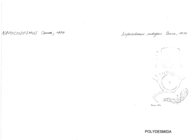MilliBase
MilliBase taxon details
Napocodesmus endogeus Ceuca, 1974
938543 (urn:lsid:marinespecies.org:taxname:938543)
accepted
Species
Ceuca, T. (1974). Noi contributii la cuonasterea diplopodelor din fauna României - New contributions to the knowledge of Diplopoda of the Roumanian Fauna. Studia Universitatis Babes-Bolyai, Seria Biologia, 19: 91-97. Cluj
page(s): 94 [details]
page(s): 94 [details]
Type locality contained in Romania
type locality contained in Romania [details]
Sierwald, P.; Decker, P.; Spelda, J. (2025). MilliBase. Napocodesmus endogeus Ceuca, 1974. Accessed at: https://www.millibase.org/aphia.php?p=taxdetails&id=938543 on 2025-09-11
Date
action
by
original description
Ceuca, T. (1974). Noi contributii la cuonasterea diplopodelor din fauna României - New contributions to the knowledge of Diplopoda of the Roumanian Fauna. Studia Universitatis Babes-Bolyai, Seria Biologia, 19: 91-97. Cluj
page(s): 94 [details]
additional source Ceuca, T. (1992). Quelques aspects sur la faunistique l'écologie et la zoogeographie des diplopodes de la Région Balkanique. Bericht des naturwissenschaftlich-medizinischen Vereins in Innsbruck, Supplementum, 411-429. Innsbruck
page(s): 416 [details]
additional source Kime, R. D.; Enghoff, H. (2011). Atlas of European Millipedes (Class Diplopoda) Volume 1 Orders Polyxenida, Glomerida, Platydesmida, Siphonocryptida, Polyzoniida, Callipodida, Polydesmida. <em>Fauna Europaea Evertebrata.</em> 3: 1-282; June 2011.
page(s): 72; note: Described from nine females found in the garden. The sample from Moldova also consisted of females only. [details]
additional source Antić, D.; Vagalinski, B.; Stoev, S.; Akkari, N. (2022). A review of the cavernicolous Trichopolydesmidae (Diplopoda, Polydesmida) from the Carpathian-Balkan arch and the Rhodope Mountains, with descriptions of two new genera and three new species. <em>ZooKeys.</em> 1097: 1-46., available online at https://doi.org/10.3897/zookeys.1097.83916
page(s): 12; note: The type species of this genus, N. endogeus, was described based on nine females found in the soil near the Biology Department at the University of Cluj in Romania (Ceuca 1974). Akkari and Enghoff (...
[details]
page(s): 94 [details]
additional source Ceuca, T. (1992). Quelques aspects sur la faunistique l'écologie et la zoogeographie des diplopodes de la Région Balkanique. Bericht des naturwissenschaftlich-medizinischen Vereins in Innsbruck, Supplementum, 411-429. Innsbruck
page(s): 416 [details]
additional source Kime, R. D.; Enghoff, H. (2011). Atlas of European Millipedes (Class Diplopoda) Volume 1 Orders Polyxenida, Glomerida, Platydesmida, Siphonocryptida, Polyzoniida, Callipodida, Polydesmida. <em>Fauna Europaea Evertebrata.</em> 3: 1-282; June 2011.
page(s): 72; note: Described from nine females found in the garden. The sample from Moldova also consisted of females only. [details]
additional source Antić, D.; Vagalinski, B.; Stoev, S.; Akkari, N. (2022). A review of the cavernicolous Trichopolydesmidae (Diplopoda, Polydesmida) from the Carpathian-Balkan arch and the Rhodope Mountains, with descriptions of two new genera and three new species. <em>ZooKeys.</em> 1097: 1-46., available online at https://doi.org/10.3897/zookeys.1097.83916
page(s): 12; note: The type species of this genus, N. endogeus, was described based on nine females found in the soil near the Biology Department at the University of Cluj in Romania (Ceuca 1974). Akkari and Enghoff (...
The type species of this genus, N. endogeus, was described based on nine females
found in the soil near the Biology Department at the University of Cluj in Romania
(Ceuca 1974). Akkari and Enghoff (2011) cited this species from deep soil in an or-
chard in Moldova. Before that, Golovatch and Kime (2009) stated that this species is
very common and abundant in Moldova’s apple orchards, but probably accidentally
under the name N. florentzae, instead of N. endogeus.
 Present
Present  Inaccurate
Inaccurate  Introduced: alien
Introduced: alien  Containing type locality
Containing type locality
